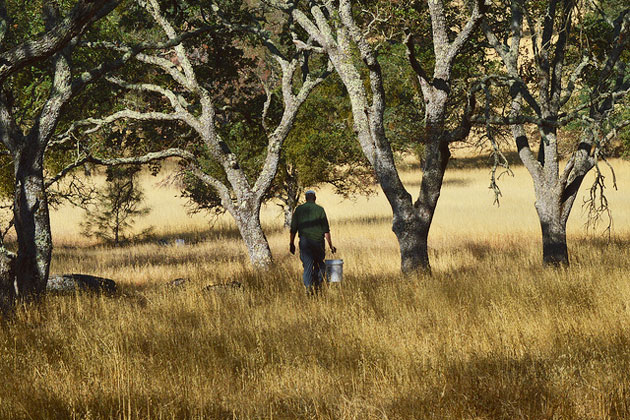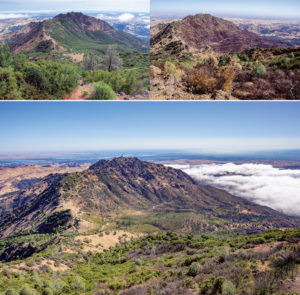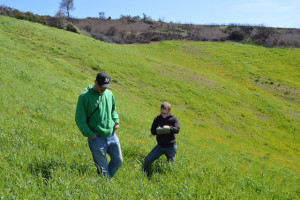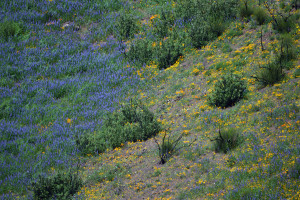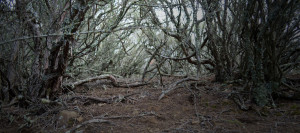This article is part of a monthly series of photos and articles on the transformation of Mount Diablo following the 2013 Morgan Fire, funded by special donations from Bay Nature readers. You can find our stories, as well as event listings, iNaturalist sightings, and magazine features, at baynature.org/diablo.
n a late September walk, Mount Diablo is parched, quiet, and still. Life seems suspended—until a tiny insect lands on Kip Will’s shoulder. It’s a brown, tick-like parasite that makes a living sucking blood from deer. Most hikers would brush it away with a scowl. But Will waves me over for a closer look. “A hippoboscid fly,” he says. “They’re so cool!”
Will is an expert on insects and other arthropods—creatures with external skeletons and no backbones. When his duties as a UC Berkeley associate professor and museum director allow, he roams the world to find new species and figure out where they fit in the arthropod family tree. His specialty is woodland ground beetles. With 4,000–5,000 species worldwide, and 100 species in California, they’re in the third largest beetle group, “carabids.” He’s pursued them in South America, Australia, and all over North America.
Today, though, woodland ground beetles aren’t the only quarry. Will is chasing down the effects of the 2013 Morgan Fire in Mount Diablo State Park. Each month around the time of the new moon (when the darkness makes arthropods more active), he traps for four days. In five years, he hopes to have the best record yet of what arthropods live on the mountain, and how they’ve responded to the fire.
Will and a student, Alyssa Zhang, have fashioned 60 “pitfall” traps, designed to catch arthropods that crawl on the ground. Half are inside and half outside areas that burned. Raccoons made mischief with some of the traps they constructed in July, so they are spending this morning with a pick, shovel, drainage pipe, plastic cups, and chicken wire shoring them up. After two hours, Will is covered with sweat and dust. “Isn’t science glamorous?” he quips.
Less laboriously, Will sets up four traps for flying insects. For night-flyers, he has ultraviolet “light traps.” For day-flyers, he has tent-like “Malaise traps,” named for the Swedish entomologist René Malaise, who invented them in 1934. All three kinds of traps are invisible to park visitors unless they know where to look.

ver the past few months, Will has seen fewer arthropods in the burned areas than in the unburned ones. But that could change. “There’s a lag time,” he says. Right after a fire, arthropods have little to feed on (though a few species such as termites and charcoal beetles, move in to take advantage of the dead wood). After rains come, there’s a flush of greenery—and more creatures arrive to feast on the plants. By that time, charcoal beetle larvae will be maturing in the dead wood. Next in line are their parasites. Some of these fire-following insects might not show up in his traps until the second or third year of the study.
It’s painstaking work, requiring academic skills Will never dreamed he’d acquire. He “narrowly escaped” his Ohio high school and joined the Army at 18. He served for eight years, in Korea, Kentucky, and Hawaii. His scientific awakening happened in Honolulu while volunteering at Bishop Museum. He thought he’d be put to work on a whale exhibit, but soon found himself in the entomology department staring at soil mites. That set his course.
“Everybody was so kind and enthusiastic,” Will says. “If these people could get so excited about soil mites, I decided there must be something to it.” He took night courses to boost his academic skills and went on to earn a bachelor’s degree at Ohio State in 1994, and a Ph.D at Cornell in 2000.
Now he’s the one who’s excited. He rhapsodizes about “hot, buggy nights,” admires choice beetle specimens, and taps away at an insect blog. His field, beetle taxonomy, is still a frontier. While about 350,000 of the world’s beetles have been written up in scientific literature, a larger number are incognito.
“It’s not crazy to think we could triple the number of ground beetles worldwide,” Will says. “But we stand to lose many species before we get around to describing them or even get a good estimate of how many are out there.”

ven places like Mount Diablo are full of unknowns, which Will finds exciting—and frustrating. “We are still very ignorant about life, right here and now, even in our own backyards,” Will says. “Unfortunately there aren’t enough resources going toward taxonomy—and the conservation that would be based on that knowledge.”
When we check the traps later in the week, we find a sprinkling of ants, flies, bees, wasps, moths, termites, spiders, bristletails, centipedes, and a scorpion. That’s impressive, given how lifeless the mountain seems in the fall. But it’s nothing in the fecund world of arthropods. There’ll be more quantity and variety after the rains come—this year and in the four years of the study to follow.
The mere thought of rain gets Will talking about rain beetles. They’re a 3-cubic inch scarab beetle that eats the roots of grasses and lives in oak woodlands. Mount Diablo looks like good habitat for them, but they’ve never been recorded here. To see them, you have to be out in the dark in the rain. “Is there any better thrill than seeing the flash of beetle as it flies through the mist-filled track of your headlamp light?” Will asks in his blog.
The night after our first meeting, a quarter-inch of rain splashes down on the study site. I ask Will whether that drew him out in the dark with his headlamp. No, he says, rousing rain beetles takes an inch or more. “We’ll just have to wait.”

